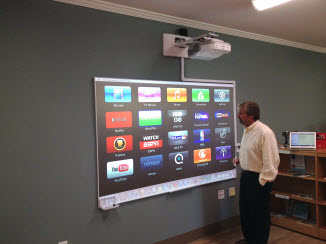Clayton-Bradley STEM Academy: Teaching with Real-Time Collaboration Technology
Clayton-Bradley STEM Academy: Teaching with Real-Time Collaboration Technology
- Partnership and interaction with innovative companies to bring a real world, “you are there” flavor to classrooms.
- The use of collaborative technology as a bridge between the classroom and the world of research and development.
The school’s systems designers chose cloud-based Cisco Merkati, to provide a WiFi-fi LAN. Complementing it with inFocus Monopad interactive endpoints fulfills two crucial requirements of the school: the network not only serves as the conduit for long-distance real-time learning, but, since all students and teachers are issued their own iPads, it also allows CBSA to be completely wireless and untethered.
By using mobility devices, the academy introduces students first-hand to the prevalence of collaboration in today’s workplace. With the latest high-tech tools at their fingertips, teachers can readily set up virtual field trips to laboratories and R&D companies who put STEM subjects to work every day.
 Since audio visual components play a big part in CBSA’s curriculum, planners had to research a bevy of AV devices including interactive projectors, and Apple-compatible software. They chose the Epson Brightlight 436Wi portable projector and the Epson 485Wi wall mount projector. Both network-ready, wireless projectors have on-board software and interactive pens that allow users to directly annotate the projection, doing away with the need for connected PC’s.
Since audio visual components play a big part in CBSA’s curriculum, planners had to research a bevy of AV devices including interactive projectors, and Apple-compatible software. They chose the Epson Brightlight 436Wi portable projector and the Epson 485Wi wall mount projector. Both network-ready, wireless projectors have on-board software and interactive pens that allow users to directly annotate the projection, doing away with the need for connected PC’s.
Using these, teachers are able to schedule long-distance, real-time presentations from labs or research centers, or have the invitee send ahead a presentation so that, as the guest speaker and the class interact wirelessly, “face-to-face,” she can draw or make notations on the presentation, or even pause a video to illustrate or accent a particular frame.
The journey of CBSA is one worth following. Based on a dream shared by Kevin Clayton, developer of Clayton Homes, in nearby Maryville, and Patricia Bradley, retired principal of Woodland Elementary School in Oak Ridge, respected for her 31 years as an educator, the project materialized with warp speed.
- Clayton and Bradley finalized their plan in the fall of 2012, anointing the future academy with the name that reflects their joint effort.
- Ground breaking followed in February 2013,
- A Request for Proposals was issued, with M3 Technologies being awarded the project in June 2013.
- Doors opened the following month, on July 19, 2013, admitting 140 Kindergarten to Grade 6 students.
CBSA is still growing, planning to add a higher grade a year until it provides K-12 schooling. Let’s hope the news of its collaborative technique of providing students with a hands-on technical education and a ready-to-jump-into-the-real-world attitude gives birth to similar STEM endeavors.
For more on the evolution of CBSA from dream to reality, see M3 Technologies’ case story.







